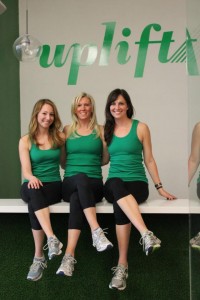I’m so excited about this week’s Marathons+Moderation guest post that I actually wanted to post it sooner than Wednesday! Last week after watching the women’s marathon with Meghann, we both were talking about how much we’d love to run that marathon one day. We weren’t alone either. Twitter was buzzing with London Marathon excitement after the Olympics and I’d be surprised if their entry rate at this point isn’t higher than normal already. Much to my elation, Charlie reached out to me via email to see if I’d be interested in letting her share her London Marathon story through Marathons+Moderation. Heck yes!

Hi Healthy Happier Bear readers, I’m Charlie and I blog at The Runner Beans. I am so excited that Ashley has let me share my first marathon story with you. This April I ran the London Marathon 2012, and was thrilled to achieve my goal of finishing in under 5 hours!
I actually trained for the London marathon in 2011, but had to pull out due to an ITB injury. Thankfully I was lucky enough to be running for a great charity, MIND, who allowed me to defer my entry and sponsorship money to the following year.
When starting marathon training for the second time I decided to do things a little differently, so here are my tips for first time marathoner:
Your plan has to work for you… Having a training plan that worked with my life; both work and social schedules, meant that I stuck to it. If I had been overambitious with the number and distances of my runs, I can imagine that I would have found it overwhelming and may have been tempted to quit. I kept my mileage low during the week, sticking to 3-5 miles during three weekday runs, only upping my mileage, gradually, on my weekly long runs. This worked really well for me, especially for my first marathon where my main goal was to finish. It meant I could easily fit my runs in before work and could squeeze in other workouts. Be realistic and work out a safe, achievable plan to get
you to marathon fitness.

All the gear…Whilst running is a very accessible sport where you don’t need too much equipment to start, the most important thing to get right is your shoes. This year, unlike the last, I went and had my gait analysed at a shoe store in London, running on a treadmill whilst being filmed to check the degree of pronation in my feet when I run. It turned out that I overpronated quite a bit, and was given very supportive shoes to protect my feet and improve my running style. This definitely helped with the pain in my knees and feet after long runs. Other than shoes, you can kit yourself out with as much or as little as you want/can afford.
Cross Train… During training this year, I didn’t JUST run. The previous year I was new to running, and just getting back into the exercise game, and I didn’t really think about incorporating strength or cross training into my routine. I ran 4 days a week and that’s it. This year, I included weekly yoga sessions plus some weight and circuit sessions in and felt my whole body getting stronger. It took some of the pressure of my knees, improved my core strength, and allowed me to retain a little flexibility.
Have a cause… I originally signed up to run the marathon in memory of one of my best friends, raising money for MIND, a mental health charity. Having such a worthy cause ensured that I stuck to my training plan as I didn’t want to let his family down, or my friends and family that had donated to the cause. Every time I wanted to put off a run, I’d think about why I was doing it, and lace up my shoes and get out there.

Practise makes perfect… This year I signed up for three half marathons and a 5k. I found it far easier to complete long runs that were scheduled races, plus the appeal of a medal and goody bag never gets old! I ran two of these half marathons with my friend Emily, who I was also planning on running the London Marathon with. It was great to work out our goal paces and our race day strategies together. These half marathons were brilliant practises for the big one. During one of my half marathons my ipod was dead leaving me music-less for all 13 miles, and during another half,
my garmin decided to switch off halfway through. These minor setbacks during my half marathons, ensured that I didn’t make the same mistakes on the big day. Plus I realised that I really like running half marathons! (I’m doing another in 2 months time!)
You don’t have to do it alone… I ran the whole of the London Marathon with Emily, and don’t think I would have had as much fun during the race, nor would I have been able to finish so strongly without her. Hitting the wall at mile 20 was miserable, but having Emily by my side telling me I was strong and had to keep going, that she wasn’t leaving me, kept me running. Without her, there is a very real possibility that I would have stopped and walked.

Enjoy your race… This is one of the most important pieces of advice I was given. You will only run your first marathon once. You may run other marathons, but nothing will ever feel quite like the first time you cross the finish line. I loved (almost) every moment of the London Marathon. The course itself is so impressive, running past huge London landmarks. One of my favourite moments was running across iconic Tower Bridge, marking about the halfway point. We also ran through areas of London that I had never been to before, including the Cutty Sark. The crowds on the day were amazing; it was great having so much support from the thousands of people lining the streets, something that we wouldn’t have had in a smaller race. I also hugely appreciated the support of friends and family on the sidelines, a huge benefit of running a race that’s local to you.

I crossed the finish line in 4.54.59 hrs, holding Emily’s hand with a huge smile on my face.
“One day you won’t be able to do this, today is NOT that day.”
Question: Have you ever run a marathon in a different country?










